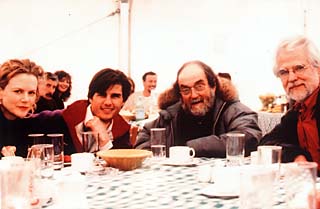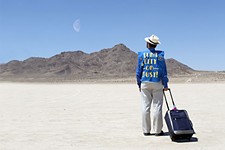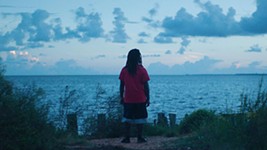For 2001, a Kubrick Odyssey
The Texas Documentary Tour: 'Stanley Kubrick: A Life in Pictures'
By Anne S. Lewis, Fri., Oct. 12, 2001

Jan Harlan's Stanley Kubrick: A Life in Pictures (2001) often feels like an Oscar-night Lifetime Achievement tribute -- complete with celebrity talking heads, from reverential narrator Tom Cruise to reverential directors Martin Scorsese and Woody Allen, to name just a few. Thoroughly enjoyable. At the same time, it feels a bit like a trial where the defendant has pled the Fifth, forcing the jury to cobble the truth from the subjective testimony of others. We don't hear much from Kubrick, though there are lots of photo montages, and some terrific home movies. True, the film was made after Kubrick's sudden death in March 1999, soon after completing his controversial Eyes Wide Shut. But, given the filmmaker's well-known obsession with privacy, the film that Kubrick's brother-in-law and frequent executive producer made -- with the cooperation of Kubrick's family, including wife, Christiane Harlan Kubrick -- would probably have turned out the same, had it been made while he was alive.
Harlan's goal was to set the record straight, rout out those ugly rumors circulated, typically by the British press -- "tyrannical," "reclusive," "obsessive," even "clinically insane" -- about the American-born, British resident Kubrick over the course of a 14-film career, which included, 2001: A Space Odyssey (1968), A Clockwork Orange (1971), and Full Metal Jacket (1987). If you have any doubt about the passion of Kubrick fans and kin for blasting every bit of misinformation (no, he did not wear a helmet while driving his car) and fleshing out the real Stanley (hey, he loved The Simpsons, Roseanne, and Seinfeld -- how weird could he have been?) surf the Kubrick Web sites.
Austin Chronicle: When you set out to make this film, what were the underlying questions you felt needed to be addressed?
Jan Harlan: For film buffs Stanley Kubrick clearly belongs to the great American filmmakers of his generation -- I go further and say he is one of the great artists of his generation, whether you like all his films or not. A certain degree of objectivity prevails. Having said that, I wanted to get this message across to young people, to people who knew little about Kubrick or were prejudiced by miserable newspaper articles, often copied from or influenced by the British tabloids. Melanie Viner Cuneo (the brilliant editor of the documentary) and I wanted to instill the desire to see Stanley Kubrick's films again or for the first time.
The documentary further shows Kubrick as a man, a devoted husband, family man, a hard-working artist constantly on the lookout for new territory, a lover of cats, dogs, and domestic life. The viewer will get an idea of his lifestyle, his origin, and hard struggle to get where he wanted to be. There are many topics we could not address like his love for sports, tennis, soccer, American football, boxing, etc. -- his great knowledge and love for classical music was only hinted at -- there simply was not enough screen time.
AC: Was Kubrick as enigmatic to you, his brother-in-law and colleague, as he was to the public?
JH: I knew him extremely well after working with him for 30 years on a daily basis. But our relationship started much earlier when we played with the children, played table tennis or "needle-dropped" through stacks of LPs discussing classical music. During the decade before I started working with him, our relationship was limited to these topics and family dinners -- he was married to my sister since 1958. He then asked me in 1969 to "do a job for him," i.e., work as liaison with the Romanian military authorities on a project on the life of Napoleon, which he was going to film in Romania. We would have had 5,000 pieces of cavalry under contract, including men and commanding officers, to film Napoleon's Italian campaign. I moved to England for pre-production, thinking I'd go Romania six months later. But the project fell apart, as you see in the film.
Was he enigmatic? I suppose so -- the most enigmatic part of any great artist is his talent. Artistic talent is a mystery. His films had enigmatic elements, and he certainly didn't like to talk about them or explain anything. He gave great credit to his audience and trusted that they would figure it out. He was wrong there in many cases, and that pained him. He didn't mind a bad review but he was very sad when he realized the critics simply didn't get it. His untimely death at least spared him the mockery in the U.S. and British press after Eyes Wide Shut. The great success of that film in Japan and in the Latin world would not have consoled him after the failure in the U.S., which was truly his home, although he lived in England.
He didn't talk to the press because he was shy, felt he wasn't good at it, and hated to explain his films, and he never appeared on TV or radio. The British press, particularly the so-called tabloid press, disliked him since he never talked to them or responded to their insults. Stanley happily ignored the press, he was self-assured enough. It was different when the antagonism culminated in a concerted attack on him after A Clockwork Orange, which resulted in Stanley asking Warner Bros. to withdraw the film in Britain. He was most uncomfortable and also hurt at that time.
I am sometimes asked what Stanley feared. My glib and superficial answer is: a room full of strangers asking him about the meaning of the end of 2001: A Space Odyssey. Seriously, he didn't like the superficiality and was taken aback by critics who saw his film once and then hacked out a poor review for the next day's edition, clearly not taking in all the subtleties which his films contain. Reading this type of review he'd sometimes say: "OK, I am only a filmmaker, but at least I work for a living."
On the other hand, he gave a number of long interviews after each film -- admittedly as a concession to Warner Bros. -- and usually to the same people like Richard Schickel of Time, Jack Kroll of Newsweek, Alexander Walker in London, or Michel Ciment in Paris.
AC: So, what was Kubrick really like?
JH: Fast, energetic, difficult, short-tempered, argumentative, dictatorial, very caring if someone or an animal had a problem, full of black humor, very generous toward contributors of good ideas and toward people who cared, suffered no fools and hated non-caring attitudes and superficiality in all areas. Always on the lookout for clever solutions and he sometimes went overboard, for example, when he suggested to my wife that she install a remote control thermometer in our baby's bed, so that she could always know that the temperature under the blanket was just right.
AC: When he made a film, would he articulate what he was trying to accomplish thematically or technically?
JH: On technical topics he was very articulate and communicative, in order to work with his gaffer, art department, special effects people. But he did not discuss the film itself or only in very general terms. The so-called orgy scene in Eyes Wide Shut, for example, was supposed to be completely stylized, removed from all reality, a Hieronymus Bosch-like canvas, depicting an abyss of decadence and sinfulness. Had he lived, I am sure he would have slightly altered this scene, emphasizing more the voyeurs, who, after all, are the center of the scene, rather than what they arranged for their gratification.
AC: Do you know which of his films he was most pleased with? Or disappointed in?
JH: Difficult question, since he did not look back. He was not interested in his old films and only watched them to check the first print of a new inter-negative, for example. He liked his films and was proud of most of them. Eyes Wide Shut was a particularly hard film for him to make, and he was very pleased with the result.
His films are very different in form, but there is a common thread that goes through all of them, which is a focus on human folly, on the fact that we are, in all important matters, not guided by our intellect, knowledge, education, or ability to think analytically -- but by our emotions. This is what interested him so in Napoleon -- this hugely talented and clever man whose downfall was self-inflicted.
His most commercially successful films were 2001: A Space Odyssey, A Clockwork Orange, and Full Metal Jacket. Eyes Wide Shut will be, I am sure. He was very disappointed that Barry Lyndon was so poorly received in the USA and UK -- although it played to packed houses in France, Italy, and Spain, but, as I said before, this did not console him. He was so proud of his super-fast f 0.7 lens, which enabled him to do the candlelight shots and equally proud of the sets, costumes, wigs, make-up -- he felt that Barry Lyndon was the first film that truly captured the 18th century. But the moviegoing audiences in America and Britain didn't care about this.
AC: Who were his mentors?
JH: There were many -- Julius Caesar and Napoleon, on the one hand; Steven Spielberg, Woody Allen, Martin Scorsese, Ingmar Bergman, Carlos Saura, Edgar Reitz, to name just a few, on the other. He was a hungry reader, devoured literary reports and books all the time and he was a film buff, watching almost everything, if he had time. We usually had half a dozen 35mm prints of new films sitting in the projection booth on a Saturday night and he would watch the first double-reel of all of them but would not necessarily finish them all.
He offered his project A.I.: Artificial Intelligence to Steven Spielberg in 1994, because he felt Steven had the edge for this huge fairy tale. I was shocked when he told me. But here is the sign of great intelligence -- it is the humility to grant another artist that he or she may be more suitable for a particular story.
AC: How do you answer the critics' charge that Kubrick's films feel cold and angry?
JH: These critics were partly right, but they don't look close enough to balance this coldness with the other element: respect for humanity. Look at the end of Paths of Glory when the soldiers step out of their uniforms and are mankind. Not Frenchmen, but they are all of us, naked with their emotions sitting on their lap -- and we fully identify with them. We recognize ourselves, the best in us. Or look at the end of 2001 -- a deep, respectful bow to an unknown Creator of this beautiful and mysterious Universe, the recognition of our marvelous potential. Or look at the end of A.I.: Artificial Intelligence, a masterpiece by Steven Spielberg based on Stanley's script and concept. Kubrick had the same ending whereby the audience simply witnesses without explanation these highly sophisticated figures having developed the potential of humanity for peaceful cooperation and greatest technical achievement, having left the envy and rivalry of their old masters behind, together with their broken souls.
Stanley Kubrick: A Life in Pictures will be presented as part of the Texas Documentary Tour on Wednesday, October 17, 8pm, at the Alamo Drafthouse Downtown (409 Colorado). Filmmaker Jan Harlan will introduce the film and conduct a Q&A session following the screening. Advance tickets can be purchased by Austin Film Society members through noon Tuesday atwww.austinfilm.org/kubrick. Remaining tickets will go on sale at 7pm on the day of the show. Admission prices are $6 per show for the general public; $4 for Austin Film Society and KLRU members and students. The Texas Documentary Tour is a co-presentation of the Austin Film Society, the University of Texas RTF Dept., The Austin Chronicle, KLRU-TV, and SXSW Film.










